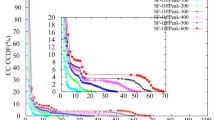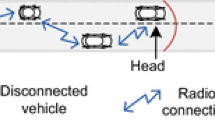Abstract
Vehicular Ad Hoc Networks (VANETs) can provide value-added services to both drivers and passengers with on-board vehicular communication systems. Node mobility and volatile wireless connection in VANETs affect inter-contact time (T I ) between mobile nodes, which greatly degrades the performance of vehicular applications. Nevertheless, the node spatial distribution in VANETs is another important factor especially in real applications. It positively affects the inter-contact time of vehicular nodes. By leveraging it, we can significantly improve the performance of data transmissions and inter-vehicle communication. To this end, we investigate the data collected from around 4,000 taxisin Shanghai and propose in this paper an efficient hot road mobility model. We find that most taxis distribute on some hot roads, which makes the node spatial distribution follow the power law. Based on this observation, we propose the concepts of indirect contact and heterogeneous inter-contact time (T H ) to reveal how hot roads can change the distribution of inter-contact time. We find that the tail distribution of T H also appears the power law, and both node spatial distribution and T H distribution decay at least as the power law. We further propose a model for detecting vehicle mobility in hot roads, which can generates synthetic traces that captures both spatial and temporal features of nodes in VANETs.









Similar content being viewed by others
References
Cheng S-T, Horng G-J, Chou C-L (2011) Using cellular automata to form car society in vehicular Ad Hoc networks. IEEE Trans Intell Transp Syst 12(4):1374–1384
Yeh L-Y, Chen Y-C, Huang J-L (2011) Abacs: an attribute-based access control system for emergency services over vehicular Ad Hoc networks. IEEE J Sel Areas Commun 29(3):630–643
Kone V, Zheng H, Rowstron AIT, Zhao BY (2011) The impact of infostation density on vehicular data dissemination. Springer MONET 16(6):807–819
Ahmed Z, Jamal H, Khan S, Mehboob R, Ashraf A (2009) Cognitive communication device for vehicular networking. IEEE Trans Consum Electron 55(2):371–375
Peng Y, Chang JM (2010) A novel mobility management scheme for integration of vehicular Ad Hoc networks and fixed ip networks. Springer MONET 15(1):112–125
Bi Y, Cai LX, Shen XS, Zhao H (2013) Medium access control for qos provisioning in vehicle-to-infrastructure communication networks. Springer MONET 18(2):174–185
Zhang Z, Mao G, Anderson B (2011) On the information propagation process in mobile vehicular Ad Hoc networks. IEEE Trans Veh Technol 60(5):2314–2325
Liu J, Ren F, Miao L, Lin C (2011) A-adhoc: An adaptive real-time distributed mac protocol for vehicular Ad Hoc networks. Springer MONET 16(5):576–585
Zhu H, Li M, Fu L, Xue G, Zhu Y, Ni LM (2011) Impact of traffic influxes: revealing exponential intercontact time in urban vanets. IEEE Trans Parallel Distrib Syst 22(8):1258–1266
Cai H, Eun DY (2009) Crossing over the bounded domain: from exponential to power-law intermeeting time in mobile Ad Hoc networks. IEEE/ACM Trans Networking 17(5):1578–1591
Zhao J, Cao G (2006) Vadd: vehicle-assisted data delivery in vehicular Ad Hoc networks. In: Proceedings of the 25th IEEE international conference on computer communications, pp 1–12
Zheng J, Molisch AF, Ansari N, Zhang B (2011) Recent advances in wireless communications and networking. Springer MONET 16(1):1–3
Zhang D, Huang H, Chen M, Liao X (2012) Empirical study on taxi GPS traces for vehicular Ad Hoc networks. In: Proceedings of IEEE ICC. IEEE, Ottawa, pp 581–585
Barberis C, Malnati G (2011) Design and evaluation of a collaborative system for content diffusion and retrieval in vehicular networks. IEEE Trans Consum Electron 57(1):105–112
Groenevelt R, Nain P, Koole G (2005) The message delay in mobile Ad Hoc networks. Perform Eval 62(1–4):210– 228
Ghafoor KZ, Bakar KA, Lloret J, Khokhar RH, Lee KC (2012) Intelligent beaconless geographical forwarding for urban vehicular environments. Wirel Netw 19:345–362
Zhang X, Neglia G, Kurose J, Towsley D (2007) Performance modeling of epidemic routing. Comput Netw 51(10):2867– 2891
Ko YM, Gautam N (2010) Epidemic-based information dissemination in wireless mobile sensor networks. IEEE/ACM Trans. Networking 18(6):1738–1751
Johnson DB, Maltz DA (1996) Dynamic source routing in Ad Hoc wireless networks. In: Mobile Computing, vol 353. Kluwer Academic Publishers
Bettstetter C (2001) Mobility modeling in wireless networks: categorization, smooth movement, and border effects. SIGMOBILE Mob Comput Commun Rev 5(3):55–66
Sharma G, Mazumdar R, Shroff NB (2007) Delay and capacity trade-offs in mobile Ad Hoc networks: a global perspective. IEEE/ACM Trans Networking 15(5):981–992
McNett M, Voelker GM (2005) Access and mobility of wireless pda users. SIGMOBILE Mob Comput Commun Rev 9(2):40–55
Henderson T, Kotz D, Abyzov I (2008) The changing usage of a mature campus-wide wireless network. Comput Netw 52(14):2690–2712
Ghafoor K, Lloret J, Bakar K, Sadiq A, Mussa S (2013) Beaconing approaches in vehicular Ad Hoc networks: a survey. Wirel Pers Commun 1–28
Skordylis A, Trigoni N (2008) Delay-bounded routing in vehicular ad-hoc networks. In: Proceedings of the 9th ACM international symposium on mobile Ad-hoc networking and computing. ACM, New York, pp 341–350
Li M, Wu M-Y, Li Y, Cao J, Huang L, Deng Q, Lin X, Jiang C, Tong W, Gui Y, Zhou A, Wu X, Jiang S (2006) Shanghaigrid: an information service grid: research articles. Concurr Comput: Pract Exper 18(1):111–135
Huang H, Zhu Y, Li X, Li M, Wu M-Y (2010) Meta: a mobility model of metropolitan taxis extracted from gps traces. In: Proceedings of IEEE. IEEE, Sydney, pp 1–6
Huang H-Y, Luo P-E, Li M, Li D, Li X, Shu W, Wu M-Y (2007) Performance evaluation of SUVnet with real-time traffic data. IEEE Trans Veh Technol 56(6):3381–3396
Li X, Shu W, Li M, Huang H, Wu M-Y (2008) DTN routing in vehicular sensor networks. In: Proceedings of IEEE GLOBECOM. IEEE, New Orleans, pp 752–756
Lee K, Yi Y, Jeong J, Won H, Rhee I, Chong S (2010) Max-contribution: on optimal resource allocation in delay tolerant networks. In: Proceedings of 29th IEEE INFOCOM. IEEE Press, Piscataway, pp 1136–1144
Moran PAP (1950) Notes on continuous stochastic phenomena. Biometrika 37(1/2):17–23
Anselin L (1996) The moran scatterplot as an ESDA tool to assess local instability in spatial association. In: Fischer M, Scholten HJ, Unwin D (eds) Spatial analytical perspectives on GIS: GISdata 4. Taylor & Francis, London, pp 111–125
Ghafoor KZ, Bakar KA, Lee K, AL-Hashimi H (2010) A novel delay- and reliability- aware inter-vehicle routing protocol. Netw Protocol and Algoritm 2(2):66–88
Tarique M, Hossain A, Islam R, Hossain CA (2010) Issues of long-hop and short-hop routing in mobile Ad Hoc networks: a comprehensive study. Netw Protocol and Algoritm 2(2):107–131
Acknowledgments
This work is supported by the National Natural Science Foundation of China (Grant Nos. 61103185, 61100034, 61003247 and 60902053), the Natural Science Foundation of the Higher Education Institutions of Jiangsu Province (Grant No. 11KJB520009), the Natural Science Foundation Project of Chongqing (Grant No. CSTC 2010BB2210), the 51st Chinese Postdoc Science Foundation (Grant No. 2012M510932) and the Fundamental Research Funds for the Central Universities (Grant No. 106112013CDJZR180004).
Author information
Authors and Affiliations
Corresponding author
Rights and permissions
About this article
Cite this article
Zhang, D., Huang, H., Zhou, J. et al. Detecting Hot Road Mobility of Vehicular Ad Hoc Networks. Mobile Netw Appl 18, 803–813 (2013). https://doi.org/10.1007/s11036-013-0467-6
Published:
Issue Date:
DOI: https://doi.org/10.1007/s11036-013-0467-6




